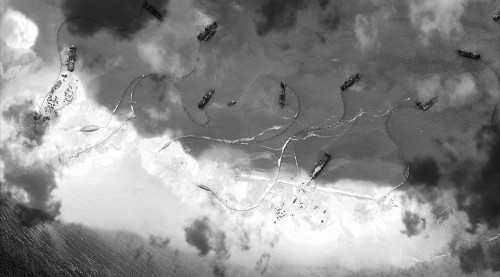 CHINA CONSTRUCTED islands in the South China Sea.
CHINA CONSTRUCTED islands in the South China Sea.Satellite images have revealed China’s numerous structural modifications on existing islands and the construction of artificial islands in the South China Sea. These modifications include the building of airstrips and what China’s neighbors fear to be various military facilities. China claims almost 90 percent of the South China Sea and disputes various islands with Japan and South Korea. China maintains that it has the right to conduct construction projects in its sovereign territory. In recent years, China’s assertive activities in disputed waters have caused problematic friction with its neighbors (e.g., Japan, Vietnam, and the Philippines).
Last year, for example, China’s relations with Vietnam cooled after a Chinese oil rig relocated in the waters of the Paracel Islands, 120 miles from Vietnam’s coast, which is within Hanoi’s 200-mile exclusive economic zone as determined by international law. Public outcry and anti-Chinese sentiment in Vietnam resulted in large riots and the displacement of many Chinese shop owners and damaged Chinese businesses. Since then, Chinese and Vietnamese diplomats have worked to rebuild ties and understanding.
Chinese scholars cite historical documents and maps in defense of China’s territorial claims. Furthermore, Chinese state media have accused the U.S. of violating its pledge to remain neutral regarding disputes in the South China Sea through its use of its Cold War era containment strategy to pit other countries up against China.
Traditionally, the U.S. is hesitant to pick sides in territorial disputes between China and its neighbors. U.S. Admiral Harry Harris Jr. has commented on recent developments, stating that China is “creating a great wall of sand,” which not only causes serious damage to the coral reefs in the area, but also hampers the effectiveness of the U.S. Navy. The head of U.S. Pacific Command, Admiral Samuel Locklear, has stated that the pace and scope of China’s building program is “astonishing.” A main concern is that China may use the relevant islands and improvements to solidify its claims in the region. Such influence would result in control over the world’s most vital shipping lanes.
In response to the changing nature of the region, the U.S. is looking to bolster economic and military ties with Vietnam and the Philippines. The South China Sea is, as Admiral Locklear would describe it, “the most militarized part of the world,” in regards to the concentration of naval vessels. The U.S. plans to rebalance 60 percent of its fleet to the Asia Pacific region by 2020.
